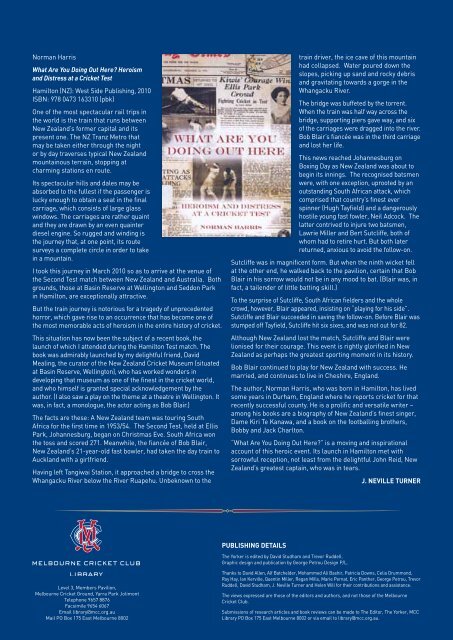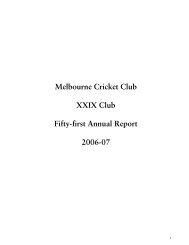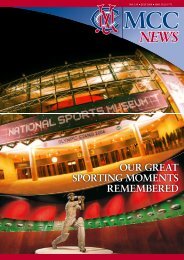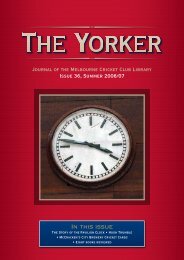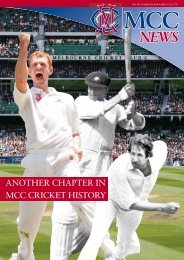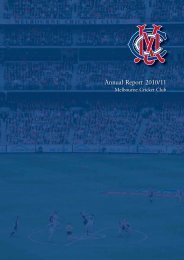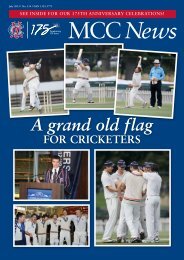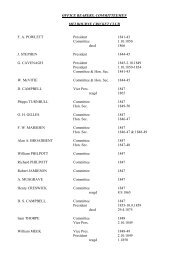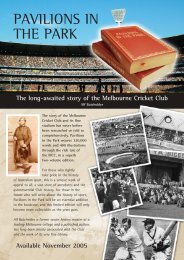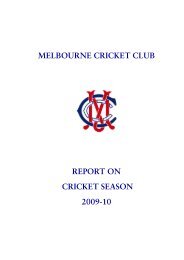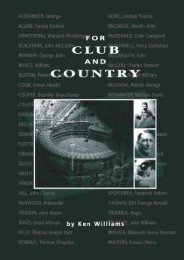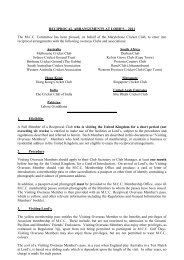Issue 42: Spring 2010 - Melbourne Cricket Club
Issue 42: Spring 2010 - Melbourne Cricket Club
Issue 42: Spring 2010 - Melbourne Cricket Club
You also want an ePaper? Increase the reach of your titles
YUMPU automatically turns print PDFs into web optimized ePapers that Google loves.
Norman Harris<br />
What Are You Doing Out Here? Heroism<br />
and Distress at a <strong>Cricket</strong> Test<br />
Hamilton (NZ): West Side Publishing, <strong>2010</strong><br />
ISBN: 978 0473 163310 (pbk)<br />
One of the most spectacular rail trips in<br />
the world is the train that runs between<br />
New Zealand’s former capital and its<br />
present one. The NZ Tranz Metro that<br />
may be taken either through the night<br />
or by day traverses typical New Zealand<br />
mountainous terrain, stopping at<br />
charming stations en route.<br />
Its spectacular hills and dales may be<br />
absorbed to the fullest if the passenger is<br />
lucky enough to obtain a seat in the final<br />
carriage, which consists of large glass<br />
windows. The carriages are rather quaint<br />
and they are drawn by an even quainter<br />
diesel engine. So rugged and winding is<br />
the journey that, at one point, its route<br />
surveys a complete circle in order to take<br />
in a mountain.<br />
I took this journey in March <strong>2010</strong> so as to arrive at the venue of<br />
the Second Test match between New Zealand and Australia. Both<br />
grounds, those at Basin Reserve at Wellington and Seddon Park<br />
in Hamilton, are exceptionally attractive.<br />
But the train journey is notorious for a tragedy of unprecedented<br />
horror, which gave rise to an occurrence that has become one of<br />
the most memorable acts of heroism in the entire history of cricket.<br />
This situation has now been the subject of a recent book, the<br />
launch of which I attended during the Hamilton Test match. The<br />
book was admirably launched by my delightful friend, David<br />
Mealing, the curator of the New Zealand <strong>Cricket</strong> Museum (situated<br />
at Basin Reserve, Wellington), who has worked wonders in<br />
developing that museum as one of the finest in the cricket world,<br />
and who himself is granted special acknowledgement by the<br />
author. (I also saw a play on the theme at a theatre in Wellington. It<br />
was, in fact, a monologue, the actor acting as Bob Blair.)<br />
The facts are these: A New Zealand team was touring South<br />
Africa for the first time in 1953/54. The Second Test, held at Ellis<br />
Park, Johannesburg, began on Christmas Eve. South Africa won<br />
the toss and scored 271. Meanwhile, the fiancée of Bob Blair,<br />
New Zealand’s 21-year-old fast bowler, had taken the day train to<br />
Auckland with a girlfriend.<br />
Having left Tangiwai Station, it approached a bridge to cross the<br />
Whangacku River below the River Ruapehu. Unbeknown to the<br />
train driver, the ice cave of this mountain<br />
had collapsed. Water poured down the<br />
slopes, picking up sand and rocky debris<br />
and gravitating towards a gorge in the<br />
Whangacku River.<br />
The bridge was buffeted by the torrent.<br />
When the train was half way across the<br />
bridge, supporting piers gave way, and six<br />
of the carriages were dragged into the river.<br />
Bob Blair’s fiancée was in the third carriage<br />
and lost her life.<br />
This news reached Johannesburg on<br />
Boxing Day as New Zealand was about to<br />
begin its innings. The recognised batsmen<br />
were, with one exception, uprooted by an<br />
outstanding South African attack, which<br />
comprised that country’s finest ever<br />
spinner (Hugh Tayfield) and a dangerously<br />
hostile young fast fowler, Neil Adcock. The<br />
latter contrived to injure two batsmen,<br />
Lawrie Miller and Bert Sutcliffe, both of<br />
whom had to retire hurt. But both later<br />
returned, anxious to avoid the follow-on.<br />
Sutcliffe was in magnificent form. But when the ninth wicket fell<br />
at the other end, he walked back to the pavilion, certain that Bob<br />
Blair in his sorrow would not be in any mood to bat. (Blair was, in<br />
fact, a tailender of little batting skill.)<br />
To the surprise of Sutcliffe, South African fielders and the whole<br />
crowd, however, Blair appeared, insisting on “playing for his side”.<br />
Sutcliffe and Blair succeeded in saving the follow-on. Before Blair was<br />
stumped off Tayfield, Sutcliffe hit six sixes, and was not out for 82.<br />
Although New Zealand lost the match, Sutcliffe and Blair were<br />
lionised for their courage. This event is rightly glorified in New<br />
Zealand as perhaps the greatest sporting moment in its history.<br />
Bob Blair continued to play for New Zealand with success. He<br />
married, and continues to live in Cheshire, England.<br />
The author, Norman Harris, who was born in Hamilton, has lived<br />
some years in Durham, England where he reports cricket for that<br />
recently successful county. He is a prolific and versatile writer –<br />
among his books are a biography of New Zealand’s finest singer,<br />
Dame Kiri Te Kanawa, and a book on the footballing brothers,<br />
Bobby and Jack Charlton.<br />
“What Are You Doing Out Here?” is a moving and inspirational<br />
account of this heroic event. Its launch in Hamilton met with<br />
sorrowful reception, not least from the delightful John Reid, New<br />
Zealand’s greatest captain, who was in tears.<br />
J. Neville Turner<br />
Publishing Details<br />
The Yorker is edited by David Studham and Trevor Ruddell.<br />
Graphic design and publication by George Petrou Design P/L.<br />
Level 3, Members Pavilion,<br />
<strong>Melbourne</strong> <strong>Cricket</strong> Ground, Yarra Park Jolimont<br />
Telephone 9657 8876<br />
Facsimile 9654 6067<br />
Email library@mcc.org.au<br />
Mail PO Box 175 East <strong>Melbourne</strong> 8002<br />
Thanks to David Allen, Alf Batchelder, Mohammed Ali Bashir, Patricia Downs, Celia Drummond,<br />
Roy Hay, Ian Kerville, Quentin Miller, Regan Mills, Marie Pernat, Eric Panther, George Petrou, Trevor<br />
Ruddell, David Studham, J. Neville Turner and Helen Will for their contributions and assistance.<br />
The views expressed are those of the editors and authors, and not those of the <strong>Melbourne</strong><br />
<strong>Cricket</strong> <strong>Club</strong>.<br />
Submissions of research articles and book reviews can be made to The Editor, The Yorker, MCC<br />
Library PO Box 175 East <strong>Melbourne</strong> 8002 or via email to library@mcc.org.au.


